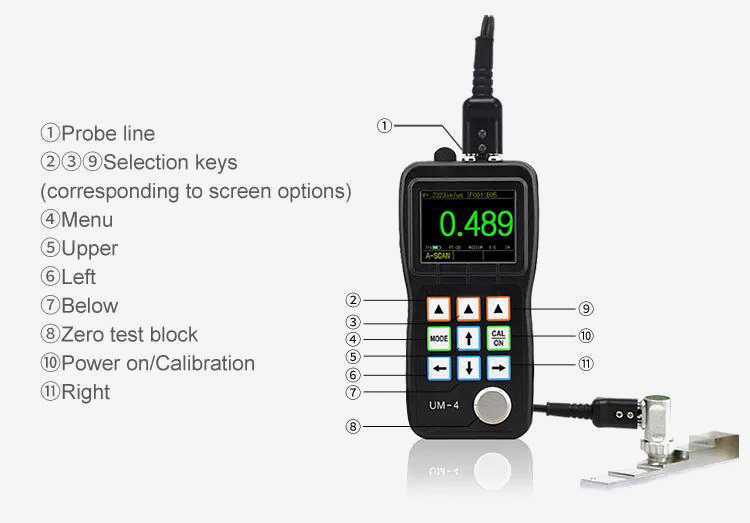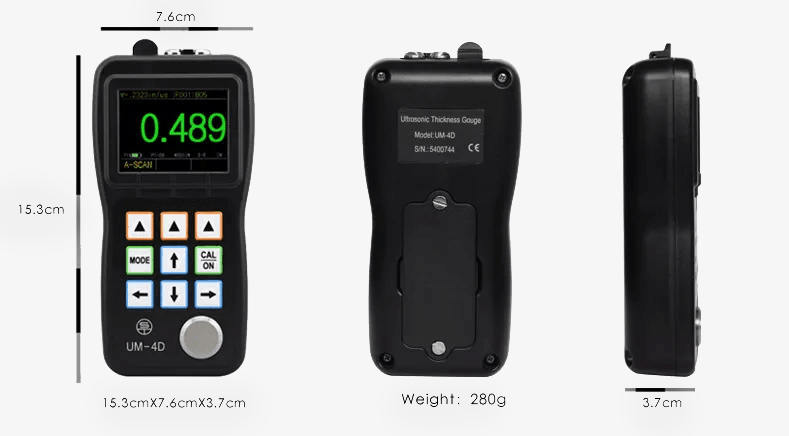sisco digital A-scan ultrasonic thickness gauge is perfect for measuring the thickness of metal materials, pipes, pressure vessels, sheet metals (steel, aluminum), plastic, steel pipes, PVC pipes, glass and other materials. The high precision ultrasonic thickness meter provides a total measuring range from 0.6mm to 508mm, high resolution 0.01mm or 0.001 inches, material velocity range 500 to 9999 m/s (0.0197 to 0.3939 in/μs), A-scan display view, update rate 4Hz/8Hz/16Hz, high/medium/low gain, OLED color display.

Digital A-scan ultrasonic thickness gauge can directly measure the material's thickness.
- High resolution 0.01mm or 0.001 inches
- Measuring range: 0.6-508mm
- A-scanning snapshot function
- Zero cross-measurement, high stability and reliability
- Bright OLED color display
- Adjustable High, Medium or Low gain
- Update rate 4Hz, 8Hz, 16Hz for selections, 4Hz for ordinary application, 8Hz and 16Hz for quicker scan
- Through coating, no need to remove the paint (UM-4D, UM-4DL Only)
- Large data logger, ultrasonic thickness gauge can store 100,000 thickness values (UM-4DL Only)
Details
Applications
sisco handheld ultrasonic thickness gauge is used to measure metallic and non-metallic materials, including plastic, steel, PVC and glass plates and pipes. It can be widely used in manufacturing, metal processing and other fields, and can also perform corrosion and thinning detection on various pipes and pressure vessels in manufacturing facilities.

| Model | SISCO-UM-4 | SISCO-UM-4D | SISCO-UM-4DL |
| Display Type | 2.4" color OLED, 320×240 pixels, contrast 10,000:1 | ||
| Operating Principle | P-E (pulse-echo) with dual element transducers | P-E (pulse-echo), E-E (echo-echo) with dual element transducers | P-E (pulse-echo), E-E (echo-echo) with dual element transducers |
| Total Measuring Range | 0.6mm-508mm (0.025"-20.00"), depending on material, probe and surface condition | ||
| Measuring Range (Standard Probe) | PT08: 0.8-100mm | TC510: 1.2-200mm | |
| Measuring Resolution | Selectable 0.1mm or 0.01mm (selectable 0.01 inch, 0.001 inch) | ||
| Units | Inch or Millimeter | ||
| Gain | Low, Medium or High for various testing conditions | ||
| Display Mode | Normal, Min/Max capture, DIFF/RR% | ||
| V-Path Correction | Automatic | ||
| Update Rate | Selectable 4Hz, 8Hz, 16Hz | ||
| Material Velocity Range | 500 to 9999 m/s (0.0197 to 0.3939 in/μs) | ||
| Languages | Chinese, English, Japanese, French, German | ||
| Alarm Settings | Minimum and Maximum alarm. Thickness readings color dynamically change when alarming. | ||
| Power Supply | Two AA alkaline batteries | ||
| Operating Time | Approximately 35 hours | ||
| Instrument Shut-off | Selectable ALWAYS ON or AUTO OFF after 5, 10, or 20 minutes of no operation | ||
| Operating Temperature | -10℃ to +50℃ | ||
| Size | 153mm×76mm×37mm (H×W×D) | ||
| Weight | 280g including batteries | ||
Function Comparison
| Features | SISCO-UM-4 | SISCO-UM-4D | SISCO-UM-4DL |
| OLED Color Screen | Y | Y | Y |
| A-Scan Snapshot | Y | Y | Y |
| Gain: low, Medium, High | Y | Y | Y |
| Min/Max Capture | Y | Y | Y |
| DIFF/RR% | Y | Y | Y |
| Thru-paint | N/A | Y | Y |
| Data Logger | N/A | N/A | Y |
| DataView Software | N/A | N/A | Y |
Data Logger of SISCO-UM-4DL Ultrasonic Thickness Gauge
| Capacity | 100,000 thickness readings, 400 files |
| File Structure | Grid file |
| Rows × Columns | 21×12 |
| Communication Port | USB 2.0 port |
| Software | DataView PC Software |
Note:
* Standard Packing List
Ultrasonic Thickness Gauge × 1, Standard Probe × 1, Battery × 2, Couplant × 1, Carrying Case × 1, Operating Manual × 1
USB Cable × 1 (UM-4DL Only), Software × 1 (UM-4DL Only)
(Kindly Reminder: Battery and Couplant are Not Included if Shipped By Air.)
* Optional Probes
| Model | PT08 | TC510 | PT06 | PT04 | ZT12 | GT12 |
| Type | Standard | UM-5D/UM-5DL Standard |
Small Tube | Fingertipe | Cast iron | High-Temperature |
| Frequency | 5MHz | 5MHz | 7.5MHz | 10MHz | 2MHz | 5MHz |
| Diameter | 11mm | 13.5mm | 8mm | 6mm | 17mm | 15mm |
| Measuring Range | 0.8~100mm | 1.2~200mm | 0.8~30mm | 0.7~12mm | 4.0~508mm | 4.0~80mm |
| Allowable Temperature | -10℃ ~ 70℃ | -10℃ ~ 70℃ | -10℃ ~ 70℃ | -10℃ ~ 70℃ | -10℃ ~ 70℃ | -20℃ ~ 450℃ |
| Picture | 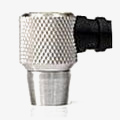 |
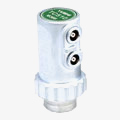 |
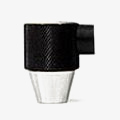 |
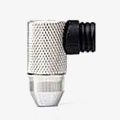 |
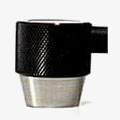 |
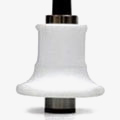 |
Dimensions
Q1: What is an ultrasonic thickness gauge?
The ultrasonic thickness gauge is improved based on the principle of ultrasonic measurement. It can measure the thickness of metals and other materials and can measure the sound speed of the material. The sisco ultrasonic thickness gauge is a portable thickness meter that can measure the thickness of various pipes and pressure vessels in production equipment, as well as accurately measure various sheets and machined parts.
Q2: How does an ultrasonic thickness gauge work?
sisco ultrasonic thickness gauge offers through-coating thickness measuring capability. It measures the thickness of an object by precisely calculating the times the probe sends an ultrasonic pulse to the object and passes through the object until the probe receives the reflection from the boundary. The ultrasonic pipe thickness gauge adopts the most advanced microprocessor and ultrasonic technology and has the characteristics of zero drift, reliable and stable reading, and no need for zero calibration. You can now test painted objects without removing paint or correcting paint thickness.
Q3: 4 Measurement methods of ultrasound thickness gauge
- Single-point measurement method: It means that the ultrasound thickness gauge is used to measure any point of the measured material with a probe, and the display value is the thickness value.
- Two-point measurement method: The ultrasound thickness meter is used to make two measurements at the same point of the measured material with a probe. In the second measurement, the probe's split surface is 90 degrees, and the smaller value in the two measurements is the thickness value.
- Multi-point measurement method: When the measurement value is unstable, take a measuring point as the center and make multiple measurements in a circle with a diameter of about 30 mm. The minimum value is the thickness value.
- Continuous measurement method: It uses a single-point measurement method to measure continuously along a designated line with an interval of not less than 5 mm. The minimum value is the thickness value.
Tips: How to calibrate the ultrasonic thickness gauge?
Before measuring the thickness with an ultrasonic thickness gauge, the lower limit and linearity of the instrument should be calibrated. The lower limit of the instrument should be calibrated by a test block whose thickness is the lower limit. If the sound velocity of the material is known, the velocity value of the ultrasonic thickness gauge can be adjusted in advance, and then the test block attached to the instrument can be used for the calibration with the "calibration key" button of the gauge. In fact, it is found that the thickness of the calibration block of different brands of UT thickness gauges is different, so we should pay attention to the thickness of the standard calibration block in the field inspection, so as not to adjust the wrong reference values.
Generally, the calibration test block attached to the ultrasonic thickness gauge is small. When the required thickness deviates from the attached one larger, the step calibration blocks is needed. The ultrasound thickness gauge shall be calibrated with the thickness close to the maximum thickness to be measured and the minimum thickness to be measured respectively (or half of the maximum thickness to be measured).
Thank you for buying industrial test and measurement equipment on SISCO.com, all products sold by SISCO and the partner cover a 12 months warranty, effective from the date of receiving the products.
What is covered?
SISCO is responsible for providing free spare parts, and free technical support to assist the customer to repair the defective products until the problem is solved.
What is not covered?
- Product purchased from anyone other than a SISCO store or a SISCO authorized reseller.
- Expendable parts.
- Routine cleaning or normal cosmetic and mechanical wear.
- Damage from misuse, abuse or neglect.
- Damage from use of parts other than SISCO approved.
- Damage from use outside the product’s usage or storage parameters.
- Damage from use of parts not sold by SISCO.
- Damage from modification or incorporation into other products.
- Damage from repair or replacement of warranted parts by a service provider other than a SISCO authorized service provider.
- Damage caused by the application environment not meeting the product usage requirements and the failure to perform preventive maintenance.

